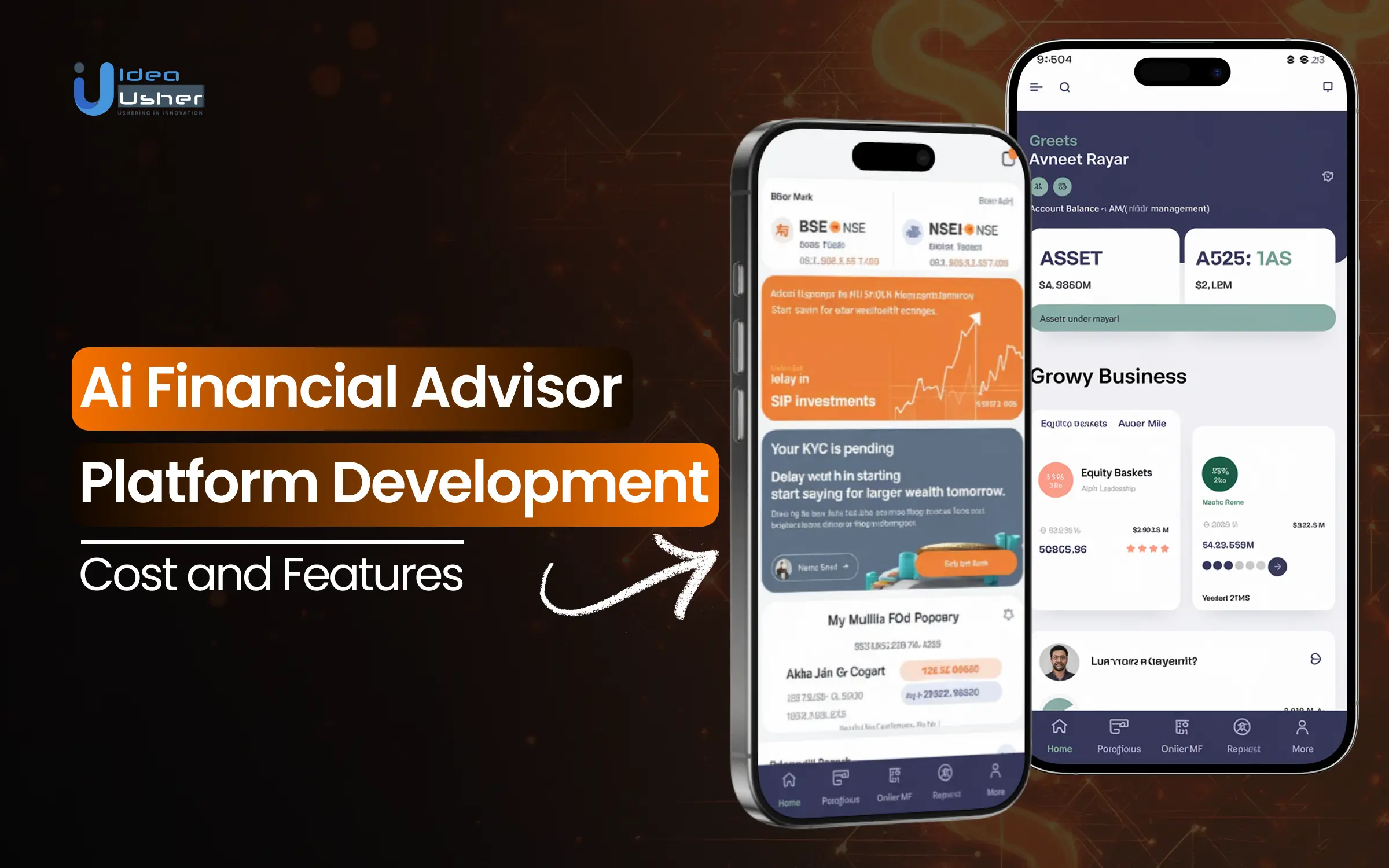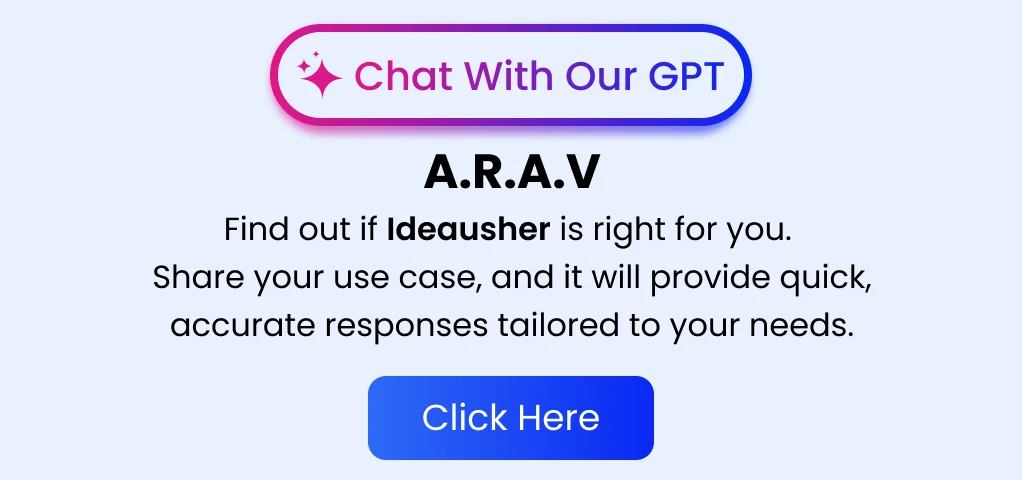AI financial adviser platforms are transforming the finance industry with faster, personalized guidance. They improve investment management and savings, making financial planning more accessible for businesses and individuals. The AI in the finance market, valued at $38.36 billion in 2024 and projected to reach $190.33 billion by 2030, shows that AI is driving innovation and enhancing decision-making worldwide.
Leading platforms like Betterment and Wealthfront exemplify this growth. Betterment’s revenue soared to $153 million in 2023, reflecting a remarkable 69% increase from $91 million in 2022.
Wealthfront also demonstrated substantial progress, managing over $75 billion in assets across more than one million accounts as of October 2024, up from $55 billion and 735,000 customers at the end of 2023.
Developing an AI financial adviser platform involves advanced machine learning, data analytics, and a seamless user experience. This blog explores the key features and costs of building such a platform, serving as a guide for developing a reliable solution for modern financial management.
Key Market Takeaways Of AI In Financial Services
The global AI for financial services market is poised for remarkable growth. It is projected to reach USD 80.9 billion by 2034, up from USD 2.1 billion in 2024. This substantial expansion, driven by a robust compound annual growth rate (CAGR) of 43.8% from 2025 to 2034, underscores the increasing adoption of AI technologies across the financial sector.

As financial institutions seek to enhance operational efficiency, improve customer experiences, and deliver personalized financial solutions, AI-powered platforms are becoming integral to the industry’s evolution.
This rapid growth highlights the significant opportunities for businesses investing in AI-driven financial services and the transformative potential of AI in reshaping financial advisory, risk management, and investment strategies.
Best Time To Invest In AI Financial Adviser Platform
Investing in an AI adviser improves customer experience, efficiency, and cuts costs. These platforms provide personalized advice, automate tasks, and enhance fraud detection. AI handles 80% of advisory tasks, lightening human workload. By using AI, firms reduce labor costs, offer 24/7 support, strengthen relationships, and boost satisfaction.
Wealthfront’s success exemplifies this trend, with its revenue nearly doubling to $200 million in 2023, driven by AI-powered investment strategies and automated financial advisory services.
Similarly, Betterment increased its assets under management (AUM) from $30.7 billion in 2022 to $38.35 billion in 2023, demonstrating the growing profitability and demand for AI in financial advisory services.
These platforms are highly adaptable and can be tailored to various financial sectors, from investment management to banking, helping firms reduce operational costs and enhance client engagement. Investing in AI-powered financial advisory solutions today positions businesses for sustained growth and success in an expanding and competitive market.
Core Features of an AI Financial Adviser Platform
Incorporating key features into an AI financial advisor ensures personalized, secure, and efficient guidance, enhancing users’ financial management experience.
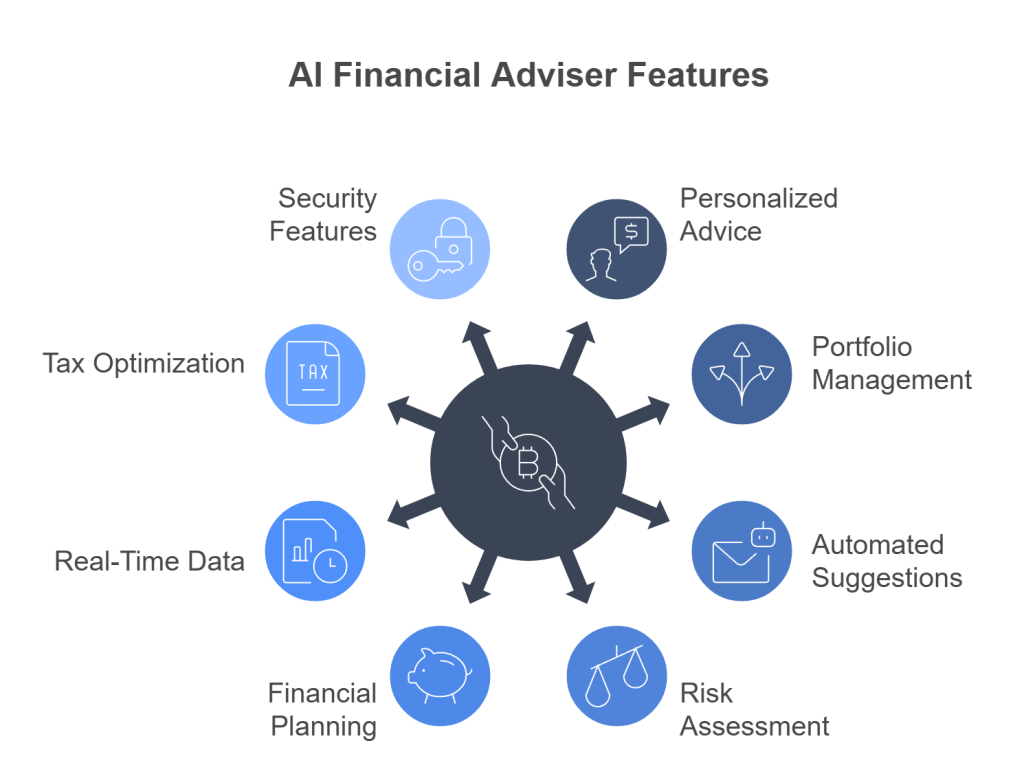
1. Personalized Financial Advice
An AI financial adviser platform provides personalized advice by allowing users to create profiles that include income, goals, risk tolerance, and investment preferences. Users can set specific objectives like retirement planning, education savings, or property purchase. The AI utilizes this data to create tailored strategies, offering guidance through personalized roadmaps and progress tracking.
2. Portfolio Management
Portfolio management is essential for financial adviser platforms. Users track investment performance in real time and compare it with market benchmarks. The platform provides asset allocation suggestions aligned with user goals and risk profiles, ensuring a diversified and optimized portfolio. An intuitive dashboard allows users to adjust based on market changes and monitor financial growth confidently.
3. Automated Investment Suggestions
Automated investment suggestions enhance user experience via AI-driven robo-advisory services. The platform recommends investments and rebalances portfolios based on market conditions. Ongoing AI trend analysis enables diversification strategies to minimize risk and maximize returns effortlessly, simplifying investment while ensuring strategic management.
4. Risk Assessment and Management
Robust risk assessment tools enable effective evaluation and management of financial risks. The platform conducts detailed profiling to measure user risk tolerance, aligning investment strategies with comfort levels. Advanced features like stress testing simulate portfolio performance under various market conditions, helping users assess investment resilience and make informed decisions during market volatility.
5. Financial Planning Tools
Comprehensive financial planning tools empower users to manage their daily finances efficiently. Budgeting features allow users to create, monitor, and adjust their budgets while tracking expenses and identifying opportunities to save. Cash flow analysis offers a clear view of income and expenditure patterns, assisting users in maintaining financial stability and planning for future needs without unnecessary stress.
6. Real Time Data and Insights
Real time data access is crucial for any AI financial adviser platform. Users get the latest market analysis on stock performance, economic indicators, and investment opportunities. An integrated news feed informs users of relevant developments, helping them make timely, data-driven decisions aligned with their financial goals.
7. Tax Optimization
Effective tax optimization helps users minimize liabilities and plan finances efficiently. The platform provides tax planning tools for preparation during tax season. Additionally, tax-loss harvesting suggestions guide users in selling underperforming assets to offset gains, reducing tax burdens and enhancing returns.
8. Security and Privacy Features
Security and privacy are paramount in financial advisory services. The platform ensures the protection of sensitive user information through robust data encryption. Implementing two-factor authentication adds an extra layer of security, requiring users to verify their identity through multiple steps. This reduces the risk of unauthorized access and protects users’ financial data from potential threats.
9. Compliance and Regulatory Features
Adhering to financial regulations is crucial for user trust and legal integrity. The platform features compliance with regulations like Know Your Customer (KYC) and Anti-Money Laundering (AML). Transparent user agreements help users grasp the platform’s terms, risks, and responsibilities, fostering trust.
Key Components for Building an AI Financial Adviser Platform
Building an AI financial adviser platform requires essential components that ensure accurate data handling, intelligent financial analysis, and seamless user operations.
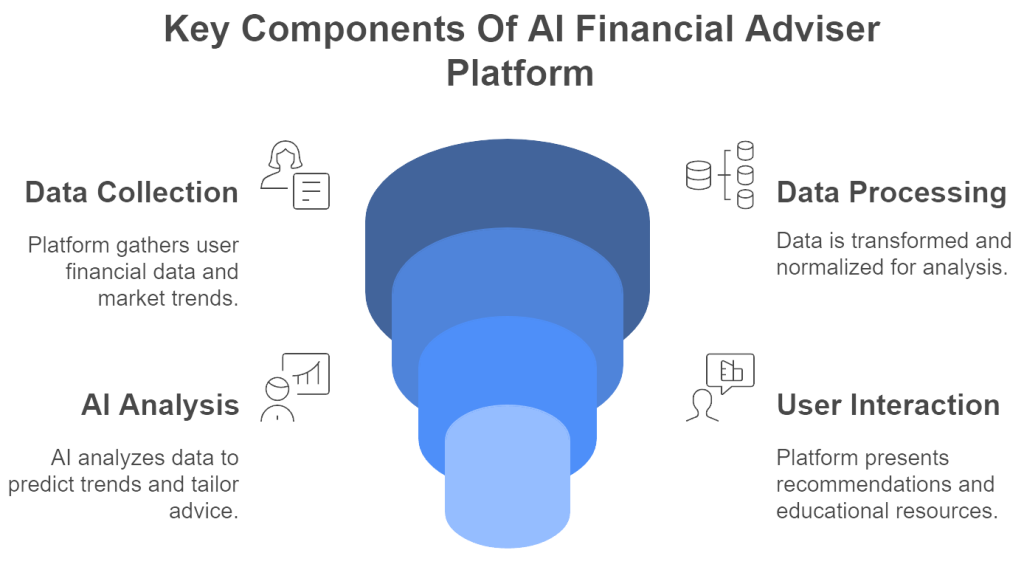
Data Ingestion and Retrieval Pipeline
- Collects data from financial markets, economic indicators, user financial profiles, and external APIs.
- Uses ETL (Extract, Transform, Load) to extract raw data, transform it into usable formats, and load it into secure databases.
- Performs data normalization for consistency across formats like currency values and transaction dates.
- Ensures real-time updates for the latest market data, user metrics, and financial insights.
AI Agent
- Utilizes machine learning algorithms trained on historical financial data to recognize market patterns and predict trends.
- Analyzes user profiles, including financial goals and risk tolerance, to provide tailored financial advice.
- Employs predictive analytics to forecast market movements and recommend investment strategies.
- Integrates natural language processing for seamless user interaction through human-like chat interfaces.
Operations Pipeline
- Provides an intuitive user interface with dashboards for financial tracking, investment performance, and personalized recommendations.
- Implements secure user management with encryption, two-factor authentication, and data protection.
- Ensures compliance with KYC (Know Your Customer) and AML (Anti-Money Laundering) standards through user verification and transaction monitoring.
- Incorporates feedback loops for continuous improvement by analyzing user interactions, gathering feedback, and refining AI algorithms.
A Simple Example to Tie It Together
Imagine a user asking an AI financial adviser platform for investment advice.
- Data Ingestion: The platform retrieves the user’s financial profile, including income, current investments, and risk tolerance (structured data). It also scans the latest market news and economic reports (unstructured data).
- AI Agent: The user asks, “What’s the best investment option for me right now?” The AI agent analyzes the user’s financial goals, evaluates market conditions, and references historical investment data to suggest suitable stocks or mutual funds. It also recalls that the user prefers low-risk investments based on past interactions.
- Operations Pipeline: While interacting, the platform notices the user is hesitant about making large investments. It flags this for the system to offer additional resources like educational articles on low-risk investments and sets a reminder to follow up with the user about their investment decisions later.
Development Steps Of An AI Financial Adviser Platform
Developing an AI financial adviser platform requires a structured approach, blending expertise with advanced AI. Here’s a guide for an accurate, secure, user-friendly platform.
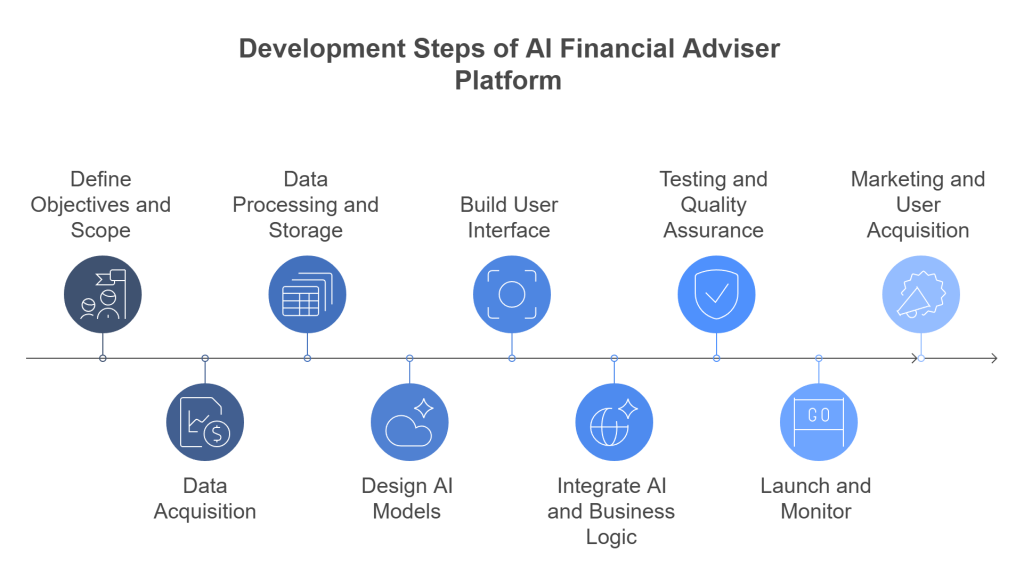
1. Define Objectives and Scope
Before starting development, clearly outline your platform’s purpose and target audience. Determine whether you are catering to individual investors, businesses, or financial institutions. Define your platform’s core objectives, such as providing investment recommendations, budgeting tools, wealth management, or tax planning. Additionally, ensure compliance with financial regulations like SEC (U.S.), FCA (UK), or GDPR (EU) to maintain legal integrity and user trust.
2. Data Acquisition
A reliable AI financial adviser depends on quality data. Integrate financial data from reputable sources such as Bloomberg, Alpha Vantage, and Nasdaq using APIs. Securely collect user financial data, including bank transactions, investment portfolios, and spending habits, while ensuring encryption and privacy compliance. The more diverse and structured the data, the better your AI will perform in providing accurate financial insights.
3. Data Processing and Storage
Raw financial data often contains errors, duplicates, or missing values. Implement data preprocessing techniques to clean and standardize the data. Store structured and unstructured data efficiently using databases like PostgreSQL for structured financial data and MongoDB for real-time user interactions. Cloud-based solutions such as AWS or Google Cloud ensure scalability, security, and ease of access for your platform.
4. Design AI Models
The platform’s intelligence depends on effective AI models. Predictive analytics forecast investment growth and market trends, while deep learning assesses portfolio risks. Natural language processing (NLP) helps process queries, understand context, and provide personalized financial recommendations. Training with historical financial data boosts accuracy, and rigorous testing ensures real-world performance.
5. Build User Interface (UI)
An intuitive interface is essential for user engagement. Design a clean, user-friendly dashboard that includes interactive charts, financial goal tracking, and AI-generated insights. Use frameworks like React.js or Flutter to ensure compatibility across mobile and web platforms. The UI should guide users seamlessly through complex financial decisions while maintaining aesthetic appeal and functional efficiency.
6. Integrate AI and Business Logic
Seamlessly integrate AI models with the platform’s business logic to provide actionable financial advice. Develop automated investment suggestions based on user preferences, spending patterns, and risk tolerance. Incorporate dynamic chatbot interactions that offer real-time financial advice and address user queries. Ensure that AI-generated insights align with financial industry standards and regulatory requirements for maximum reliability and compliance.
7. Testing and Quality Assurance
Testing is a critical phase to ensure platform stability and user satisfaction. Conduct user testing by gathering feedback from beta users to refine the interface and overall experience. Performance testing is essential to assess how well the platform processes large datasets and handles multiple user requests without lag. Security and compliance audits must be performed to verify encryption methods, user authentication processes, and adherence to regulatory standards, ensuring that sensitive financial data remains protected.
8. Launch and Monitor
Deploy the platform on a robust infrastructure capable of handling high traffic and processing real time financial data. Implement monitoring tools such as Google Analytics and Datadog to track user engagement, platform performance, and AI accuracy. Continuously gather user feedback post-launch and make iterative improvements to enhance functionality, security, and user experience.
9. Marketing and User Acquisition
A trustworthy platform requires strong marketing to reach its audience. Create a strategic marketing plan featuring SEO and content marketing through finance and AI investment blogs. Partner with fintech influencers on social media to boost visibility and credibility. Host webinars to educate potential users on how the platform simplifies financial decisions and management.
10. Maintain and Update
AI and financial markets are constantly evolving, and your platform must keep pace. Regularly update the platform with new features, improved AI models, and enhanced user experiences based on feedback and market trends. Stay informed about regulatory changes to ensure continuous compliance. Provide ongoing customer support and educational resources to help users maximize the platform’s potential.
Cost of Developing an AI Financial Adviser Platform
The cost of developing an AI Financial Adviser Platform is determined based on complexity, features, technology stack, and required integrations. The cost structure for developing the AI Financial Adviser Platform is as follows:
| Development Step | Task | Description | Estimated Cost |
| Define Objectives | Research and Planning | Identifying target audience, objectives, and compliance needs. | $2,000 – $5,000 |
| Data Acquisition | Data Collection and Integration | Integrating APIs, gathering financial data, and user data input. | $5,000 – $15,000 |
| Data Processing | Data Cleaning and Storage Setup | Preprocessing data, database design, and cloud storage setup. | $8,000 – $12,000 |
| Design AI Models | AI Model Development | Designing ML models for prediction, risk, and NLP. | $15,000 – $25,000 |
| Build UI | UI/UX Design | Creating an intuitive user interface for web and mobile. | $10,000 – $20,000 |
| AI Integration | Backend and AI Integration | Integrating AI with business logic for advice generation. | $12,000 – $20,000 |
| Testing | Platform Testing | User, performance, and compliance testing. | $5,000 – $10,000 |
| Launch | Deployment and Setup | Platform deployment, server setup, and initial monitoring. | $3,000 – $7,000 |
| Marketing | Marketing Strategy and Execution | SEO, content marketing, social media, and influencer marketing. | $7,000 – $15,000 |
| Maintenance | Ongoing Support and Updates | Regular updates, compliance checks, and user support. | $8,000 – $18,000 |
Total Estimated Budget: $10,000 – $100,000
Top 5 Examples of AI Financial Adviser Platforms
AI financial adviser platforms are transforming personal finance management through automation, personalized insights, and intelligent investment strategies. Here are the Top 5 AI Financial Adviser Platforms:
1. Wealthfront
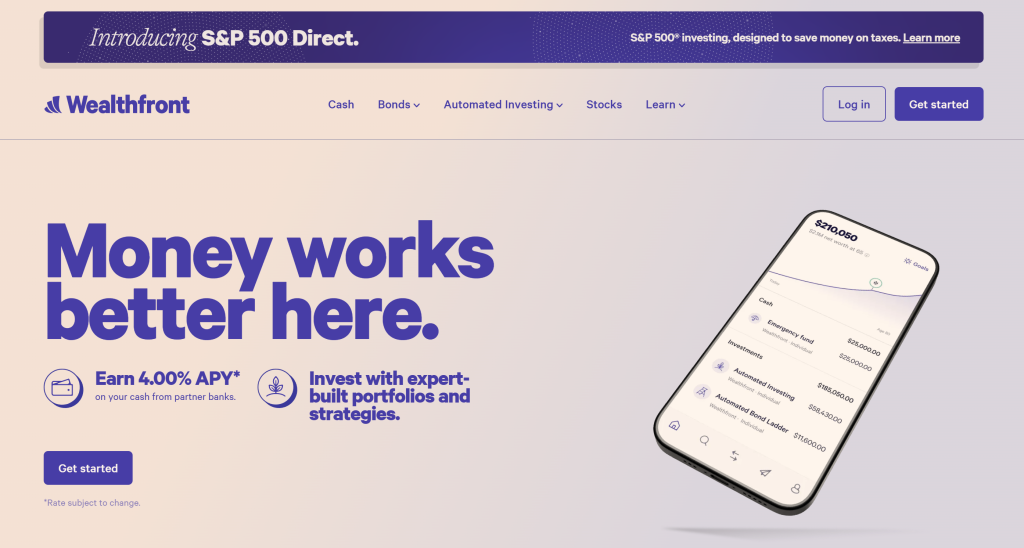
Wealthfront stands out for its fully automated portfolio management that builds diversified investment portfolios based on user risk profiles and financial goals. Its tax-loss harvesting feature enhances tax efficiency by offsetting investment losses against gains, while its financial planning tools help users plan for major life events like retirement and homeownership.
2. Betterment

Betterment offers personalized financial advice with AI-driven investment strategies tailored to individual goals and risk tolerance. Its retirement planning services provide users with customized savings plans, and its goal-based investing approach allows users to create specific targets, such as education savings, with portfolios designed to achieve those objectives efficiently.
3. Personal Capital (Now Empower)

Personal Capital combines AI-powered wealth management with personal finance tracking tools. Its investment checkup feature analyzes user portfolios to recommend improvements, while its cash flow management tools help users monitor their income, expenses, and savings. The platform’s retirement planner offers detailed projections and strategies based on current finances and future goals.
4. Robinhood

Robinhood democratizes investing with commission-free trading and AI-driven insights that provide users with personalized investment suggestions based on market trends. Its fractional shares feature makes investing accessible to users with smaller budgets, and its comprehensive educational resources guide users through informed investment decisions.
5. Zeta

Zeta focuses on joint financial planning for couples, offering tools to set and track shared financial goals and manage joint expenses. Its AI insights, based on combined financial data, provide personalized saving and investment recommendations, making it an ideal platform for couples looking to manage their finances effectively together.
Conclusion
An AI financial adviser platform is an invaluable tool in today’s digital financial landscape. It enhances financial planning by providing personalized advice, automating investment management, and optimizing tax strategies. With real-time data insights, robust security, and seamless user experiences, such platforms empower users to make informed financial decisions while streamlining operations for financial service providers. Investing in AI-driven financial solutions not only improves efficiency but also builds trust and long-term value for users and businesses alike.
Looking To Develop An AI Financial Adviser Platform?
With over 500,000 hours of coding expertise, we’re leaders in developing cutting-edge AI solutions tailored specifically for the financial industry. Our advanced AI financial adviser platforms help businesses provide personalized financial guidance, optimize investment strategies, manage risks, and enhance user experiences like never before. From predictive analytics to real-time financial insights, we empower financial organizations to leverage data-driven decisions and stay ahead of the competition. Partner with Idea Usher to unlock the full potential of AI in finance and redefine how financial advice is delivered and experienced.
Work with Ex-MAANG developers to build next-gen apps schedule your consultation now
FAQs
Q.1. How is AI used in financial advice?
AI is used in financial advice to provide personalized investment recommendations, automate portfolio management, and assess risks by analyzing vast amounts of financial data in real time. AI algorithms evaluate market trends, user financial profiles, and risk tolerance to offer tailored financial strategies, optimize asset allocation, and provide continuous monitoring and adjustments to meet user goals efficiently.
Q.2. How does an AI financial advisor work?
An AI financial advisor works by collecting and analyzing user financial data, including income, expenses, risk tolerance, and financial goals. Using machine learning algorithms and data from market trends, it generates personalized investment advice, manages portfolios, and performs tasks like rebalancing investments and tax-loss harvesting automatically. It continuously learns and adapts to provide updated and optimized financial strategies.
Q.3. Are AI financial advisors safe?
Yes, AI financial advisors are safe when built with robust security measures. Most platforms implement data encryption, secure authentication methods and comply with financial regulations like KYC (Know Your Customer) and AML (Anti-Money Laundering). However, like any digital service, users must ensure they choose reputable platforms that prioritize data privacy and security.
Q.4. What are the advantages of using an AI financial advisor?
The advantages of using an AI financial advisor include cost-effective financial management, 24/7 access to personalized financial advice, and automation of time-consuming tasks like portfolio rebalancing and tax optimization. AI advisors provide data-driven investment strategies, minimize human error, and offer scalable financial solutions for both individuals and businesses, enhancing decision-making and financial planning.
